– A framework for improving road safety, congestion alleviation and reducing emissions –
Submission supported & endorsed by
- National Motorcycle Alliance (NMA)
- Motoring Advisory Council (MAC)
- Harley Owners Group of SA (HOGSA)
- South Australian Bikers Events Rides & Socialising (SABERS)
- Jeffrey Lane (MRG Member/Riding Instructor)
- Ducati Owners Club of SA (DOCSA)
Prepared by: Tim Kelly on behalf of Ride To Review (www.ridetoreview.org)
Date: 11/04/2016
Version: 1.1
Introduction
Lane filtering (filtering) is the operating technique where a Motorcycle or Scooter [herein referred to as Powered Two Wheeler (PTW)] moves between lanes of stationary and/or slow-moving traffic (below 30kph) travelling in the same direction as the PTW.
The practice of filtering is consistent with vulnerable road user traffic separation principles in that it removes riders from being hit from behind or from striking the vehicle ahead in stop-start heavy traffic and therefore, the rider is no longer exposed to the full-force of a rear-end impact. Rather, (should a collision occur whilst filtering) the dynamic is more similar to a sideswipe lane-changing impact, which is an incomplete force ‘contact’ [1][2].
Further to this, given the static nature of stopped or dense traffic, vehicle lane changes are less likely to occur and therefore, the possibility of side swipe collisions are less likely than a Rear End Collision (REC).
Filtering is currently legal in Queensland (QLD) [3], New South Wales (NSW)[4], the Australian Capital Territory (ACT) [5] and Victoria (VIC)[6] as well as throughout most of Europe including the United Kingdom.
This submission endorses the legalisation of filtering within South Australia.
Most recently, Lane splitting (splitting) has been legalised in the State of California in the United States following the results of an extensive, and historic, research project, which found one the primary benefits of lane sharing was a reduced risk of collision and subsequent trauma for PTW operators [7].
Splitting is the operating technique where a PTW move between lanes of moving-traffic (above 30kph) travelling in the same direction as the PTW.
This submission does not endorse the legalisation of splitting at this time.
In South Australia (SA), whilst no specific infringement for filtering exists, both local and interstate PTW operators who choose to undertake filtering, as part of their road safety toolkit may, in fact, be penalised via one, or more, of the following offences, as outlined in the South Australian Road Traffic (Miscellaneous) Regulations 2014 [8].
These offences include
- 46(1). Failing to give left change of direction signal before turning left ($303)
- 46(4). Failing to stop giving left change of direction signal after turning left ($203)
- 48(1). Failing to give right change of direction signal before turning right ($303)
- 48(4). Failing to stop giving right change of direction signal after turning right ($203)
- 51. Using direction indicator lights when not permitted $203
- 141(1). Driver overtaking to left of other vehicle ($320)
- 144. Failing to keep safe distance when overtaking ($292)
- 146(2). Failing to drive within single line of traffic ($247)
- 147. Moving from one marked lane to another marked lane across continuous line ($247)
Safety Principles of Lane Filtering
It is suggested that core to the principles of filtering is ‘Threat Zone Management’, which is the identification of immediate threats and mitigating the risk of collision. To demonstrate the benefits of filtering, shown below in the image on the left, we see a non-filtering scenario in which the PTW operator is at 360 degree risk from multiple vehicles (up to 6 at a time) with an immediate threat radius that can encompass 3 distinct lanes.
However, in the filtering scenario on the right, we can see that the PTW operator is now subject to between 2 and 4 immediate threats depending on the movement at the time of the manoeuvre, and that the threat radius to the PTW has been significantly reduced to a far more manageable and scan-able area. This, in turn, increases the PTW operator’s spatial awareness of the most immediate threats, increasing the operator’s safety.
Threat Zone – Non Filtering
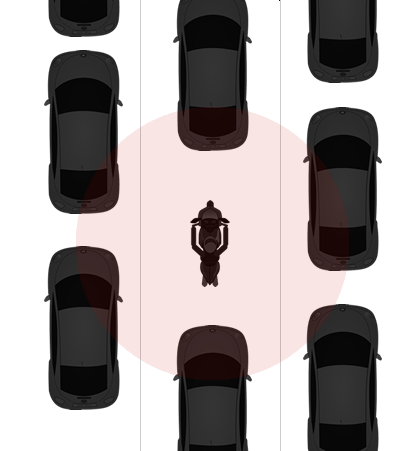
Threat Zone – Filtering
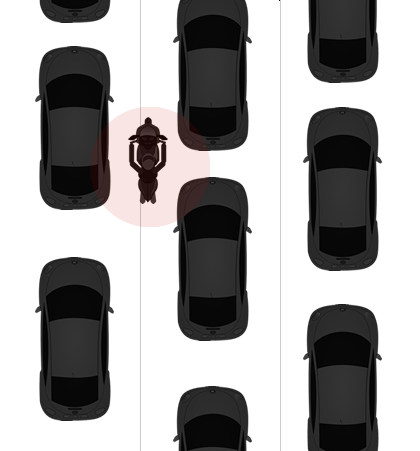
Beyond that, in instances where the PTW is moving at a speed equal to, or slightly above, the traffic flow, or particularly in a stopped traffic flow, the PTW in the filtering position will have reduced the threat from REC to almost non-existent as the vehicle and operator are no longer stopped in the queue of traffic and accessible to REC.
Therefore, whilst seemingly counter-intuitive to some unware road users, filtering is actually a viable safety technique that removes the motorcycle and rider from the danger spot behind a stopped car, and places the motorcycle into the more secure safety envelope that is created between two larger vehicles [2].
To demonstrate this, shown below is a diagram depicting how the PTW has been removed from the immediate threat of a REC collision via the practice of filtering, along with some images taken from footage involving a REC between a car and a PTW, demonstrating the forces involved with a REC.
Non Filtering
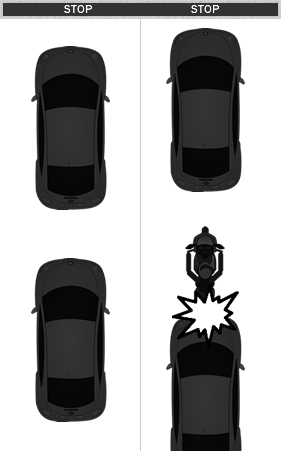
Filtering
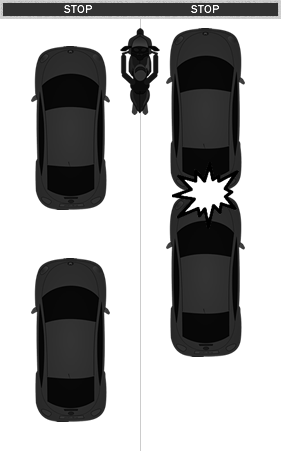
Images captured from REC involving motorcyclist and car

Further to this, other safety benefits, when comparing a REC into a PTW with a lane change type of contact (side swipe) include;
- In a lane change impact, the rider has a chance to recover and remain upright. This is unlikely in a direct rear-end contact.
- In a lane change impact, the rider has a chance to take evasive action to avoid the contact altogether. This is unlikely in a rear-end impact.
- If the rider does go down in a lane change contact, the potential injuries are not as severe as those in a direct rear-end contact [2].
In line with this, the benefits of filtering/sharing where also highlighted in the California study which found filtering/sharing PTW operators were notably less likely to suffer head injury (9.1% vs 16.5%), torso injury (18.6% vs 27.3%), or fatal injury (1.4% vs 3.1%) than other PTW operators [7] who were not filtering at the time of their collision.
Analysis of REC in SA
In South Australia a total of 71,100 collisions were recorded into the TARS database [9] for the 4 year period between 2012 and 2015, involving a total of 151,829 vehicles, or objects, which resulted in a total of 28,299 casualties being recorded [see Appendix 1 for recording scope].
From this dataset, collisions involving a PTW were isolated into a new dataset with a total of 3,636 (5.1%) unique collisions being identified involving a total of 6718 (4.4%) vehicles, or objects, which resulted in a total of 2246 (16.5%) casualties being recorded.
From the isolated dataset which examines only collisions involving PTW, a total of 613 (16.8%) unique REC were recorded on South Australian roads between 2012 and 2015, involving a total of 1329 (19.7%) vehicles, or objects, which resulted in a total of 271 (12.0%) casualties being recorded [see Appendix 1 for recording scope].
Further to this, as shown in the graph below, we can deduce that each year, on average over 150 unique REC occur on SA roads, with the data showing an overall growth rate of 50+% recorded for the 4 year period between 2012 and 2015.
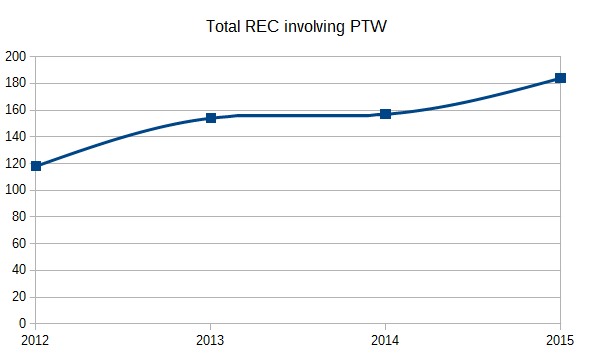
Summary of Analysis
PTW within SA are more likely to be involved in a REC
- within the Metropolitan region (82.4%)
- between Monday and Friday (79.1%)
- during the day (85.0%)
- between the peak transit hours of 6-9am (17.9%) and 3-6pm (36.1%)
- in dry weather (94.0%)
- on straight (94.6%), flat(90.9%) & sealed roads (99.3%)
- in a speed zone of 60kph or less (82.0%)
Analysis also found that for PTW operators involved in a REC at traffic controls
- 72.1% of licensed motorcyclists had an open class motorcycle license*.
- 28.1% of licensed motorcyclists had an R Date class motorcycle license*.
- 68.0% of scooter operators had no motorcycle license*.
- 32.0% of scooter operators had either an R Date or open class motorcycle license*.
*As no records exist for motorcyclists with a Learners Permit within the dataset, the analysis was unable to determine
the exact % of operators with this license type.
Additionally,
- 92.9% of all causalities from REC are operators or passengers of PTW (n = 271)
- 26.0% of all PTW involved in a REC were stopped in the queue of traffic (n = 641)
Safety Considerations for Filtering
Speed management is critical to delivering significant road safety benefits and therefore it is suggested that the maximum permitted speed at which filtering can safely be undertaken is via understanding the risk analysis of any potential casualties involved in a collision with a filtering PTW.
For pedestrians, this figure was determined in a 1979 report by Ashton and Mackay in which they found the boundary car impact speed for the transition from mostly slight to mostly severe (AIS 2+) pedestrian casualties was approximately 30kph [10] or as summarised in the ‘Motorcycle lane filtering trial Summary of trial results’, the optimal speed at which pedestrians are likely to survive a crash [11].
For PTW operators, statistical analysis undertaken in ‘Motorcycle Lane-splitting and Safety in California’ found the occurrence of injury was at its lowest when the operating speed of a PTW was below 20 MPH (32kph) in both lane filtering and non-lane filtering collisions [7].
For other vehicles, there is no research to suggest that PTW travelling at or below 30kph present any immediate risk to the occupant of any motor vehicle.
It is therefore suggested that the maximum & optimal safe operating speed for filtering is 30kph, which is also consistent with other States within Australia.
Other Benefits of Filtering
Reducing traffic congestion and improving air quality in relation to road traffic represent important challenges for our mobility and for PTW, the primary benefits of these vehicles as the main mode of transport, when combined with filtering, has been well established in that it reduces travel time for PTW, which, in turn, reduces travel costs and lowers emission costs. In fact, PTW have 21% lower emission costs than that of an average car [11].
Most recently, the Leuven-Brussels case study examined a modal shift where it examined a 10% of drivers switching to PTW with the results concluding an overall reduction in lost vehicle hours via reduced congestion of 40% [11]. As such, as more motorists become aware of the travel time benefits and improved safety of riding a PTW using filtering techniques, research would suggest that this would have a positive impact on the SA road network, particularly at peak travel times.
Recommendations for Lane Filtering
Based on the analysis of SA crash data and an extensive literary review, the following recommendations are made in relation to filtering in SA.
- Riders with a provisional or open class motorcycle licence be allowed to move between stationary or slow moving vehicles travelling in the same direction as the rider, provided they do not exceed 30kph and it is safe to do so.
- Motorcycle riders would be allowed to use bus lanes up to the posted speed providing they exit the lane prior to the stop line (where specific lighting sequences exist).
- On major roads, such as motorways, freeways and highways where the normal speed limit is 80km/h or more, a rider who holds a provisional or open class licence for riding a motorcycle may ride past stationary or slow moving traffic at speeds not greater than 30kph on the road shoulder or in an emergency stopping lane.
- With the exception of offences 46(1), 46(4), 48(1), 48(4), 51, 141(1), 144, 146(2), 147, Motorcyclists must comply with all existing road rules when lane filtering (no requirement for a new offence to be created pertaining to lane filtering).
- Learner riders would not be allowed to lane filter because of their relatively limited on-road riding and slow manoeuvring experience.
- Motorcycle riders would be prohibited from lane filtering in school zones during school zone hours.
- Motorcycle riders must ensure their vehicle does not pass the stop line at any marked intersection.
- Motorcycle riders must not filter next to a kerb/gutter or beside parked vehicles.
Summary
Ride To Review (RTR) are convinced, and our beliefs are supported by the anecdotal evidence from the Eastern States of Australia, the US and Europe who have already made this step, that legal filtering will lead to positive outcomes for rider safety, awareness, concentration and on-road behaviour, as well as reduce the number of riders fatally injured, hospitalised and/or suffering life changing injuries due to REC. RTR is also convinced that there is an advantage to other road users in terms of reduced congestion, and consequently, lower emissions from all road users due to lower trip times. We, and the aforementioned supporters of this proposal, encourage the Government of South Australia to progress this valuable life-saving reform.
Appendix
1. Recording Scope for Reported Crashes:
The database is confined to crashes which:
Were reported to the police;
- Occurred on a road as defined in the Road Traffic Act 1961;
- Were defined by the ATSB publication “Guidelines For Determining Events as Road Crashes in Australia” (published March 2000)
- Involved at least one person being killed or injured, vehicle towed away, or total property damage of $5000 or greater
- Included all bicycles, motorcycles, scooters, gophers irrespective of damage value or injury level)
From 1 January 2013, DPTI only processed ‘property damage’ crashes with an aggregated damage value of $5000 or greater. This represents a change from previous reporting, where the value of ‘property damage’ crashes processed by DPTI since July 2003 was $3000. Preceding this, property damage crash value was $1000 introduced in 1 January 1998 [9] .
References
[1] Salvatore, R. Motorcycle Filtering – Preferred Framework for Victoria (VMC), Web. 20 September 2016.
[2] Guderian, S. ‘LANE SHARING: A GLOBAL SOLUTION FOR MOTORCYCLE SAFETY’, Web. 20 September 2016.
[3] http://www.qld.gov.au/transport/safety/rules/motorcycle/#filtering, Web. 20 September 2016.
[4] http://roadsafety.transport.nsw.gov.au/stayingsafe/motorcyclists/lanefiltering/index.html, Web. 20 September 2016.
[5] http://cdn.justice.act.gov.au/resources/uploads/JACS/Road_Safety/PDFs/Q_and_A_trial_2014.pdf, Web. 20 September 2016.
[6] https://www.vicroads.vic.gov.au/safety-and-road-rules/motorcyclist-safety/motorcycle-filtering, Web. 20 September 2016.
[7] Rice, T. Troszak, L. Erhardt, T ‘Motorcycle Lane-splitting and Safety in California’, Web. 20 September 2016.
[8] South Australian Road Traffic (Miscellaneous) Regulations 2014, Web. 20 September 2016.
[9] Road Crash Data, https://data.sa.gov.au/data/dataset/road-crash-data, Web. 20 September 2016.
[10] Cuerden, R. Richards, D. & Hill. J ‘Pedestrians and Their Survivability at Different Impact Speeds’, Web. 20 September 2016.
[11] Motorcycle lane filtering trial – Summary of trial results (NSW), Web. 20 September 2016.
[12] Yperman, I. ‘COMMUTING BY MOTORCYCLE: IMPACT ANALYSIS’, Web. 20 September 2016.
